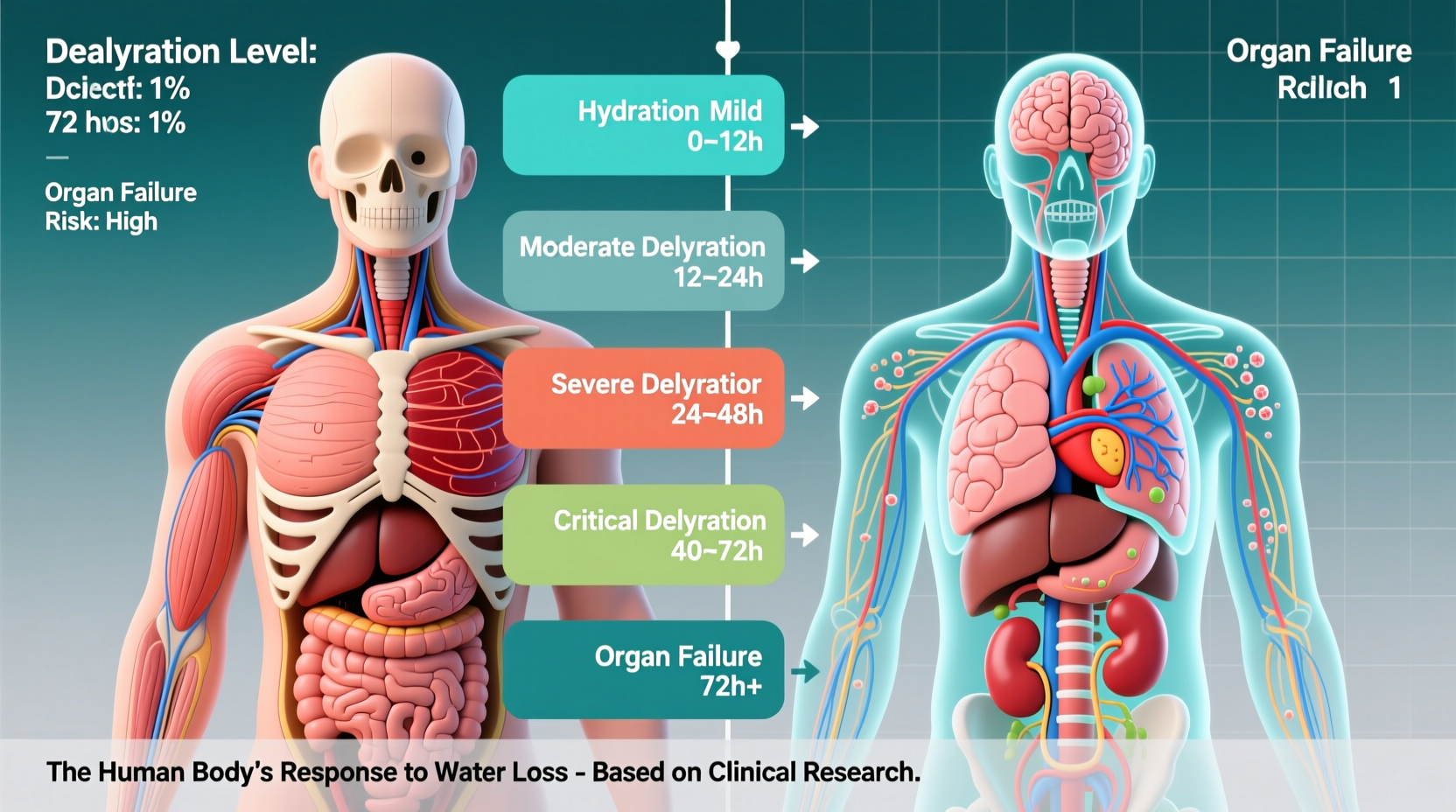Based on medical research, the average person can survive approximately 3 days without water and up to 3 weeks without food under ideal conditions. However, these timelines vary significantly based on individual health, environmental factors, and other critical variables.
Understanding human survival limits isn't just theoretical knowledge—it's potentially life-saving information. Whether you're an outdoor enthusiast, preparing for emergencies, or simply curious about human physiology, knowing the realities of survival without food and water could make the difference between life and death in critical situations.
Survival Timelines: Water vs. Food Deprivation
While the "rule of threes" provides a basic framework (3 minutes without air, 3 hours in extreme conditions, 3 days without water, 3 weeks without food), the reality is far more complex. Let's examine what happens inside your body during deprivation.
The Critical Role of Water
Water maintains blood volume, regulates body temperature, and enables cellular function. Without it, your body begins shutting down rapidly:
| Timeframe | Physiological Changes | Symptoms |
|---|---|---|
| 24 hours | 1-2% dehydration begins | Thirst, reduced urine output |
| 48 hours | 5-7% dehydration | Dizziness, rapid heartbeat, headaches |
| 72 hours | 10%+ dehydration | Organ failure begins, confusion, fainting |
| 96+ hours | Severe organ damage | Coma, death likely |
This physiological timeline comes from research published by the Centers for Disease Control and Prevention on dehydration effects during emergency situations. The American College of Sports Medicine confirms that fluid loss exceeding 2% of body weight significantly impairs physical and cognitive function.
Food Deprivation: A Different Timeline
Without food, your body follows a more extended but equally dangerous progression:
- Days 1-3: Your body uses stored glycogen for energy
- Days 4-7: Metabolism shifts to ketosis, burning fat reserves
- Weeks 2-3: Protein breakdown begins as the body consumes muscle tissue
- Week 4+: Organ failure becomes increasingly likely
According to the National Institutes of Health, complete starvation typically leads to death within 8-12 weeks, though documented cases show survival up to 70 days under optimal conditions. The Minnesota Starvation Experiment of 1944-1945 provided critical data on the physiological and psychological effects of prolonged calorie restriction.

Key Factors That Change Survival Timelines
The "3 days without water, 3 weeks without food" guideline applies only under specific conditions. These variables dramatically alter survival probabilities:
Environmental Conditions
Extreme temperatures significantly impact survival time. In desert environments above 100°F (38°C), dehydration can prove fatal in under 24 hours. Conversely, in cool, shaded environments with low activity, some individuals have survived 5-7 days without water. The American Red Cross emphasizes that heat exposure accelerates dehydration by up to 50% compared to temperate conditions.
Individual Health Factors
Your baseline health dramatically affects survival capacity:
- Body composition: Higher body fat provides more energy reserves during starvation
- Age: Children and elderly face significantly reduced survival timelines
- Pre-existing conditions: Diabetes, kidney disease, or heart conditions shorten survival windows
- Hydration status: Starting well-hydrated extends water deprivation tolerance
Behavioral Factors
What you do during deprivation matters significantly:
- Activity level: Resting conserves water and energy
- Shelter: Protection from sun and wind reduces fluid loss
- Mental state: Panic increases heart rate and fluid loss
- Water conservation: Avoiding talking and breathing through nose reduces moisture loss
Recognizing Dangerous Symptoms
Knowing the progression of symptoms helps identify critical intervention points:
Dehydration Warning Signs
Early symptoms often go unnoticed until significant damage occurs. The Mayo Clinic identifies these progression stages:
- Mild (1-2% fluid loss): Thirst, dry mouth, reduced urine output
- Moderate (3-5%): Fatigue, dizziness, headache, muscle cramps
- Severe (6-10%): Rapid heartbeat, confusion, minimal urine output
- Critical (10%+): Organ failure, unconsciousness, death
Starvation Indicators
Unlike dehydration, starvation symptoms develop more gradually but are equally dangerous:
- Week 1: Hunger pangs, irritability, difficulty concentrating
- Week 2: Fatigue, weakness, dizziness, hair loss
- Week 3: Muscle wasting, weakened immune system, organ stress
- Week 4+: Organ failure, severe weakness, coma
Practical Survival Strategies
If you find yourself in a situation with limited access to food or water, these evidence-based approaches can extend your survival timeline:
Water Conservation Techniques
- Stay in shade and minimize physical activity during peak heat
- Breathe through your nose to reduce moisture loss
- Avoid alcohol and caffeine which increase fluid loss
- Use damp cloth on neck and wrists to cool blood flow
Food Deprivation Management
- Conserve energy by resting as much as possible
- Focus on finding minimal calories rather than full meals
- Look for high-calorie natural sources like nuts or insects
- Maintain hope and mental focus to preserve will to survive
Common Misconceptions About Survival
Popular media often misrepresents survival realities. Let's clarify some dangerous myths:
- Myth: You can drink seawater to survive
Reality: Salt content accelerates dehydration—never consume seawater - Myth: Eating snow provides hydration
Reality: Melting snow internally consumes more water than it provides - Myth: Starvation causes immediate weakness
Reality: The body adapts gradually, masking early symptoms - Myth: Coffee or tea counts toward hydration
Reality: Caffeinated beverages increase fluid loss through diuresis
When to Seek Immediate Help
Recognizing critical symptoms can save your life or someone else's:
- Symptoms of severe dehydration (no urine for 12+ hours, confusion)
- Signs of heat stroke (high body temperature, hot dry skin)
- Extreme weakness preventing movement or communication
- Loss of consciousness at any point
In emergency situations, contact local emergency services immediately. The World Health Organization emphasizes that timely medical intervention significantly improves outcomes in dehydration and starvation cases.
Preparing for Emergencies
Knowledge alone isn't enough—practical preparation saves lives:
- Maintain a 72-hour emergency water supply (1 gallon per person per day)
- Store non-perishable food with 2+ year shelf life
- Learn basic water purification methods
- Carry electrolyte replacement solutions in emergency kits
- Understand local emergency resources and evacuation routes











 浙公网安备
33010002000092号
浙公网安备
33010002000092号 浙B2-20120091-4
浙B2-20120091-4